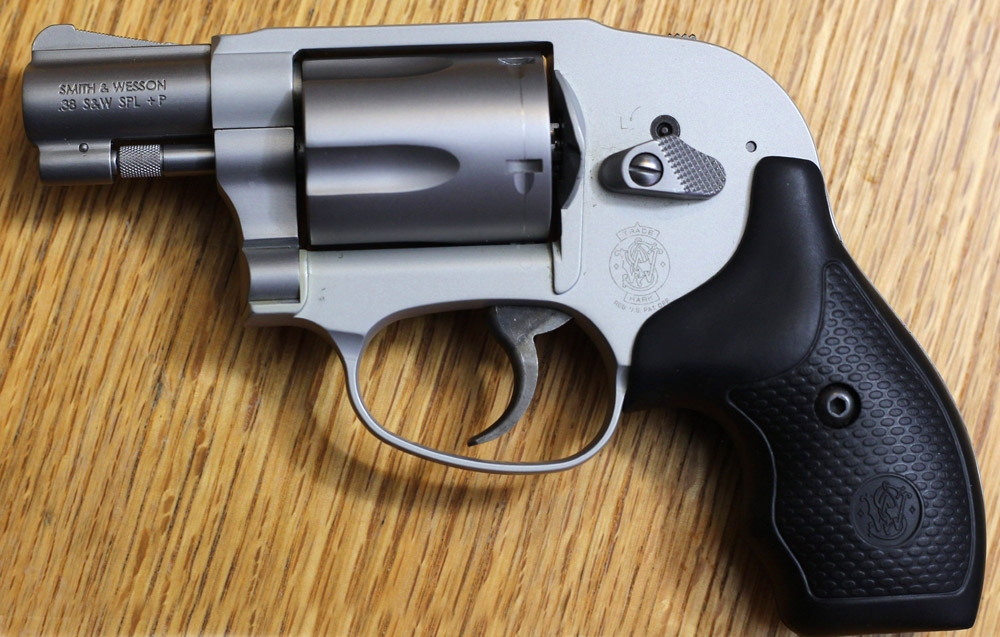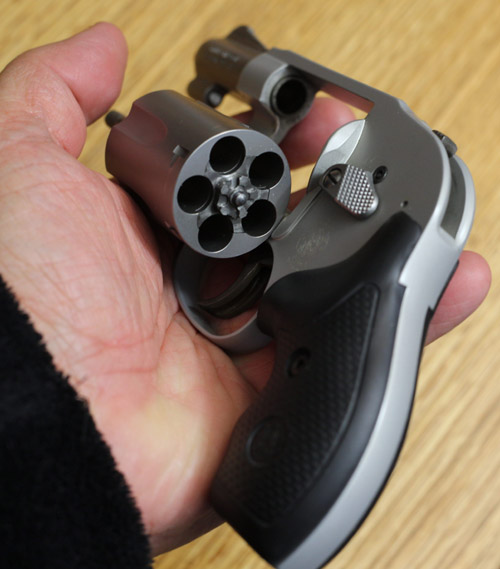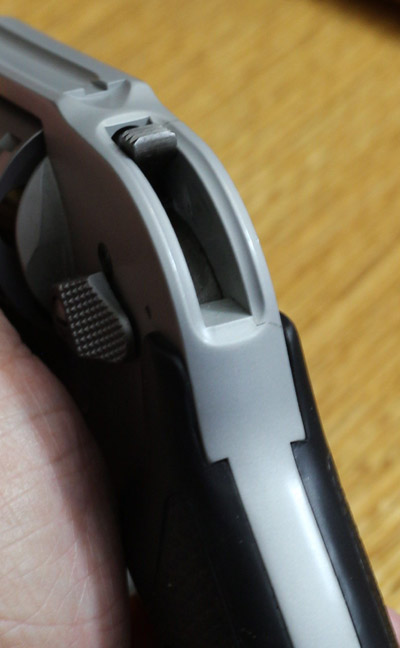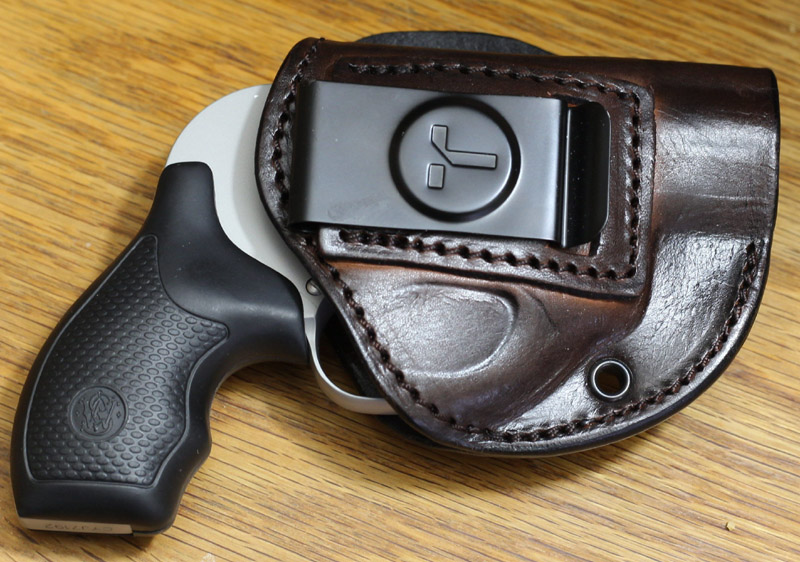S&W M638-3 Bodyguard Airweight
| Dimensions | Barrel Length | Weight | Caliber | Action Type | Magazine Capacity |
| 6.31x4.3x1.3 |
1.88 Inches |
14.6 oz |
38 |
Revolver |
5 |

I have often extolled the virtues or the humble revolver, particularly in the most extreme situations. Double action revolvers have no magazines to fiddle with, no safeties to work, no uncertainty about a chambered round or slide to rack. You load them, cock them if you like, or not, and then pull the trigger. They go bang. A revolver does not jam, fail to feed or fail to extract. a revolver is not ammunition sensitive.
The J-frame Smith is the smallest revolver frame they make. This was designed as a .32 frame, and meant to host a standard six shot revolver in 32. Smith quickly discovered that it could also base a 38 revolver on the platform if it limited the capacity to six rounds. This is a very small gun indeed, and is quite a bit more compact than all but the smallest semi autos.
 You may
notice that the photos make the frame look a bit washed out.
That's not from the photos. The frame is of aluminum alloy
coated in a white enamel. The enamel is harder and resists
scratches better than the aluminum.Of course, if you do get
a scratch or ding, you can't just polish it out. The barrel
and cylinder are stainless and have a more conventional
appearance and a bit more strength.
You may
notice that the photos make the frame look a bit washed out.
That's not from the photos. The frame is of aluminum alloy
coated in a white enamel. The enamel is harder and resists
scratches better than the aluminum.Of course, if you do get
a scratch or ding, you can't just polish it out. The barrel
and cylinder are stainless and have a more conventional
appearance and a bit more strength.The Airweight aluminum frame makes this thing very light. The polymer framed S&W Bodyguard 38 weighs just a hair less at 14.2 ounces, and is the only full power revolver I have that is lighter. My Bond Arms Derringer actually weighs more at 20 ounces. So this thing is remarkably light, toy gun light.
Rubber grips with finger cut outs for a two finger grip. Full length grips are available but defeat the purpose. Sights are fixed, non-snag, and low profile. The short barrel means a short ejector rod that will not completely clear empty cases, normal for a snub nose.
The barrel is marked 38 S&W SPL +P. Well, okay, but I will take that with a grain of salt. Between the light weight and aluminum frame, I wouldn't want to shoot too many hot loads through this. While the stainless cylinder and barrel will certainly be able to handle the pressures, I would worry about stretching and possibly deforming the aluminum frame. Additionally, small light guns are notoriously difficult to shoot well. Using hot loads just make things more difficult.
The two features that define this gun are its aluminum construction, and its shrouded hammer. This is a casual and deep cover carry gun, designed to be carried a lot and shot a little. Back in the days when revolvers reigned, this was the gun to be dropped in a pocket, and used as a back up. These are the guns for the gravest extreme.
Putting a snub nose in a handy pocket seems a natural thing to do, but it was soon discovered that the hammers snagged and caught when the gun was withdrawn. Hammer shrouds, as far as I can tell, were introduced in the fifties both as add on accessories, and as integrated features in certain model guns. and were quite popular for a while, until semi autos began to replace revolvers in police use. Yet hammer shrouds weren't just handy when carrying in a pocket.

Outside of a pocket, a snub nose can and often is carried in a concealment holster. Back in the day these were usually high ride belt holsters. Today it is more common to use a inside the waist band holster. But even from a holster, a hammer can snag on vests, jackets, and shirts. This became more noticeable with the little snub nose revolvers because they were more likely to be deeply concealed. For the standard four and six inch revolvers it was rarely a problem..
One side benefit of a hammer shroud is that it allows a revolver to do something that is not possible with a semi-auto. It allows the gun to be fired reliably from inside the pocket, without withdrawing the weapon. The slide and possibly the hammer on a semi auto will snag or be constrained inside a pocket. Being held within a pocket will also constrain the ability of a semiautomatic to eject spent cases. These are not considerations for a revolver with a hammer shroud.
In 1952, S&W decided to take this a step further. They introduced the the S&W Centennial 1952 "hammerless" small frame revolver. These guns were not truly hammerless, but had their hammer cut down and enclosed completely within the frame. They were double action only, for the obvious reason that the hammer can not be reached to be cocked. This allowed the single action portion of the lockwork to be dispensed with, and permitted tweaking the action for a better double action pull.
The removal of the single action option seemed like a food idea, and was based upon reports that in life and death confrontations, fear and adrenaline made rapid double action fire the instinctive response. Today, we see a number of double action only revolvers usually marketed towards new shooters. They are generally based upon the action of .the old Centennial. So why bother with a shrouded hammer?
Instincts aside, precision is difficult when shooting double action. This is particularly true when using a two finger hold on a short grip. Being able to cock the hammer helps quite a bit. The hammer on this gun is a little nub visible in the photo to the right. It allows for a crisp single action trigger that greatly assists in steadying the gun and keeping the sights lined up.
Shooting a gun this light and small is a real handful. Perceived recoil is jarring, in part due to the very light weight. Shooting double action, I can generally get all my shots on the paper, which is good enough. Single action it is surprising just how tight those groups can get, usually being only a few inches wide, if that. The gun has good potential accuracy that the single action pull helps me to realize. Even so, a gun this light firing a full powered cartridge is not pleasant to shoot.
 I
have two holsters for this gun. One is a pocket holster with
a suede outside and smooth inside, to prevent my drawing
both the gun and holster at the same time. The idea is to
remove the gun from the holster, rather than draw the gun
and holster together. The reason for a pocket holster, is to
keep the gun positions so that it does not roll over onto
its back.
I
have two holsters for this gun. One is a pocket holster with
a suede outside and smooth inside, to prevent my drawing
both the gun and holster at the same time. The idea is to
remove the gun from the holster, rather than draw the gun
and holster together. The reason for a pocket holster, is to
keep the gun positions so that it does not roll over onto
its back. For more conventional carry, I use a Tagua Ute Elite. This is a pretty neat holster that allows for Inside the waistband, outside the waistband, or horizontal carry in the back or on the side for use while driving or seated.
This holster, along with a pair of speed loaders, is handy, light, and unobtrusive. The allow and stainless construction means little worry about corrosion. This has become one of my favorite carry guns. As often as not I will simply drop it into a handy pocket